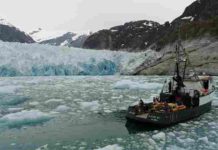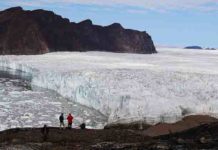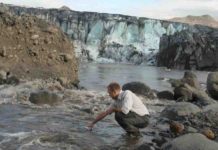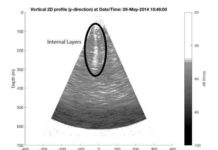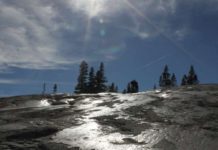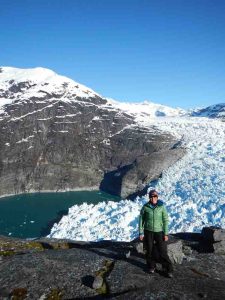
Glaciers around the world are disappearing before our eyes, and the implications for people are wide-ranging and troubling, Twila Moon, a glacier expert at the University of Colorado Boulder, concludes in a Perspectives piece in the journal Science today.
The melting of glacial ice contributes to sea-level rise, which threatens to “displace millions of people within the lifetime of many of today’s children,” Moon writes. Glaciers also serve up fresh water to communities around the world, are integral to the planet’s weather and climate systems, and they are “unique landscapes for contemplation or exploration.”
And they’re shrinking, fast, writes Moon, who returned to the National Snow and Ice Data Center this month after two years away. Her analysis, “Saying goodbye to glaciers,” is published in the May 12 issue of Science.
Moon admits she was pretty giddy when an editor at Science reached out to her to write a perspective piece on the state of the world’s glaciers, because of her research knowledge and extensive publication record. “There was some serious jumping up and down,” Moon says. “I thought, ‘I’ve made it!’ Their invitation was an exciting recognition of my hard work and expertise.”
But the topic, itself, is far from a happy one. Moon describes the many ways researchers study glacier dynamics, from in-place measurements on the ice to satellite-based monitoring campaigns to models. And she describes sobering trends: The projection that Switzerland will lose more than half of its small glaciers in the next 25 years; the substantial retreat of glaciers from the Antarctic, Patagonia, the Himalayas, Greenland and the Arctic; the disappearance of iconic glaciers in Glacier National Park, Montana, or reduction to chunks of ice that no longer move (by definition, a glacier must be massive enough to move).
In her piece, Moon calls for continued diligence by the scientific community, where ice research is already becoming a priority.
Moon says she got hooked on glaciers as an undergraduate in geological and environmental sciences at Stanford University, when she spent a semester abroad in Nepal. “For the first time I saw a big valley glacier, flowing through the Himalaya,” she said, “and I thought it was about the coolest thing ever. After studying geology, the movement and sound of the ice, right now, made it feel almost alive.'”
That experience kicked off a research career that has taken Moon to Greenland, Alaska, Norway, and to conferences around the world. She began her work “merely” as a geologist and glaciologist, interested in ice itself, Moon said. Only later did the influence of climate change come to play in her work.
“I think I’m about as young as you can get for being a person who started in glaciology at a time when climate change was not a primary part of the conversation,” says Moon, who is 35.
She is consistently sought out by journalists hoping to understand Earth’s ice, and she’s sought out in the scientific community as well, recognized as someone who likes to collaborate across disciplinary boundaries. She recently worked with a biologist in Washington, for example, on a paper about how narwhals use glacial fronts in summertime—the tusked marine mammals appear to be attracted to glaciers with thick ice fronts and freshwater melt that’s low in silt, though it’s not yet clear why.
After a couple of post-doctoral research years, at the National Snow and Ice Data Center and then the University of Oregon, Moon and her husband headed to Bristol, England, where she took a faculty position at the University of Bristol’s School of Geographical Sciences. When it became clear that her husband’s work wouldn’t transfer, the two determined to head back to the Rocky Mountains.
Moon started back as a researcher at CU Boulder’s National Snow and Ice Data Center, part of CIRES, May 1.
Reference:
“Saying goodbye to glaciers,” Science (2017). DOI: 10.1126/science.aam9625
Note: The above post is reprinted from materials provided by University of Colorado at Boulder.


